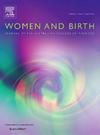Perspectives and experiences of induction of labour: An Australian cross-sectional study
IF 4.1
2区 医学
Q1 NURSING
引用次数: 0
Abstract
Problem
Despite being the most common obstetric intervention, little is known about women’s experiences of induction of labour (IOL).
Background
Rates of IOL have risen by 43 % in the past decade in Australia. There is limited evidence regarding women’s experiences of IOL. Consumer experience is a key safety and quality indicator.
Aim
To explore women’s perspectives and experiences of IOL.
Methods
A cross-sectional method via anonymous online survey, recruited and collected data from consenting women who underwent IOL regardless of gestation, level of risk or model of care, at a tertiary site. Quantitative data were analysed using descriptive and inferential statistics. Qualitative data were analysed using inductive content analysis.
Findings
A total n = 546 women participated. Most (68.9 %) were satisfied with their care. Significant differences were found in women’s experiences by parity, model of care and for those not speaking English at home. Four key categories and corresponding concepts were identified.
Discussion
Findings provide novel evidence of women’s experiences of IOL; offering new evidence, critical to contemporary maternity service planning. Inclusion of women in co-designed benchmarking of experiences and outcomes is recommended.
Conclusion
This research provides comprehensive exploration of women’s experiences of IOL in one of Australia’s largest tertiary maternity services. Findings report common and divergent perspectives useful to support clinical care reform and service redesign. Remaining gaps in evidence are highlighted with recommendations for future research including addressing the rates of primiparous IOL, the impact of continuity of midwifery carer on IOL experience outcomes; and Aboriginal women’s IOL experiences specifically.
引产的观点和经验:澳大利亚横断面研究
问题尽管是最常见的产科干预措施,但人们对妇女引产(IOL)的经历知之甚少。在过去十年中,澳大利亚人工晶状体的比例上升了43% %。关于女性人工晶状体植入经历的证据有限。消费者体验是一个关键的安全和质量指标。目的探讨女性人工晶状体植入术的观点和经验。方法采用匿名在线调查的横断面方法,从同意接受人工晶体植入的妇女中招募和收集数据,无论其妊娠、风险水平或护理模式如何。定量数据采用描述统计和推理统计进行分析。定性资料采用归纳内容分析法进行分析。总共有n = 546名女性参与了研究。大多数患者(68.9% %)对护理感到满意。在性别平等、护理模式和在家不说英语的女性的经历方面,发现了显著的差异。确定了四个关键类别和相应的概念。研究结果提供了女性人工晶状体经验的新证据;提供新的证据,对当代生育服务规划至关重要。建议将妇女纳入共同设计的经验和成果基准。结论:本研究全面探讨了澳大利亚最大的三级产科服务机构之一的女性人工晶状体手术的经验。研究结果报告了共同和不同的观点,有助于支持临床护理改革和服务重新设计。强调了证据中存在的差距,并对未来的研究提出了建议,包括解决初产妇人工晶状体的发生率,助产士护理连续性对人工晶状体经验结果的影响;以及土著妇女的人工晶状体植入经验。
本文章由计算机程序翻译,如有差异,请以英文原文为准。
求助全文
约1分钟内获得全文
求助全文
来源期刊

Women and Birth
NURSING-OBSTETRICS & GYNECOLOGY
CiteScore
7.20
自引率
13.20%
发文量
371
审稿时长
27 days
期刊介绍:
Women and Birth is the official journal of the Australian College of Midwives (ACM). It is a midwifery journal that publishes on all matters that affect women and birth, from pre-conceptual counselling, through pregnancy, birth, and the first six weeks postnatal. All papers accepted will draw from and contribute to the relevant contemporary research, policy and/or theoretical literature. We seek research papers, quality assurances papers (with ethical approval) discussion papers, clinical practice papers, case studies and original literature reviews.
Our women-centred focus is inclusive of the family, fetus and newborn, both well and sick, and covers both healthy and complex pregnancies and births. The journal seeks papers that take a woman-centred focus on maternity services, epidemiology, primary health care, reproductive psycho/physiology, midwifery practice, theory, research, education, management and leadership. We also seek relevant papers on maternal mental health and neonatal well-being, natural and complementary therapies, local, national and international policy, management, politics, economics and societal and cultural issues as they affect childbearing women and their families. Topics may include, where appropriate, neonatal care, child and family health, women’s health, related to pregnancy, birth and the postpartum, including lactation. Interprofessional papers relevant to midwifery are welcome. Articles are double blind peer-reviewed, primarily by experts in the field of the submitted work.
 求助内容:
求助内容: 应助结果提醒方式:
应助结果提醒方式:


